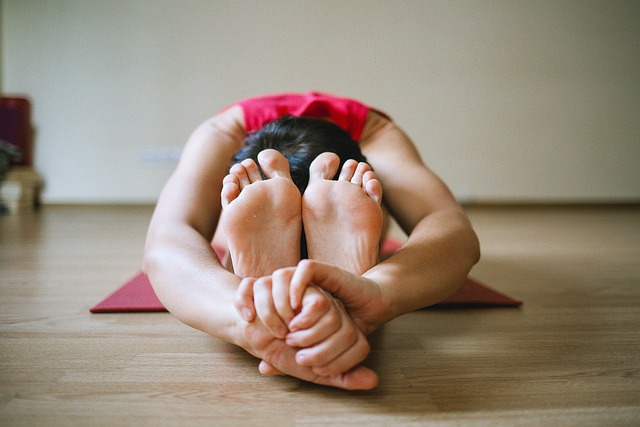Gratitude, akin to the benefits of regular yoga practices, shifts perspectives towards abundance and fosters contentment and well-being. Research shows expressing gratitude reduces stress, anxiety, depression, and increases life satisfaction and happiness. Yoga exercises, integrating physical postures, breathwork, and mindfulness, cultivate gratitude, promoting emotional resilience and strengthening relationships. Incorporating simple daily gratitude practices, like writing down three things you're grateful for, significantly enhances overall well-being. Success isn't measured by a target but by cultivating a mindset shift through consistent reflection, similar to tending a garden. Yoga exercises nurture a grateful mindset, fostering positive outlooks, enhanced resilience, deeper connections, and transforming challenges into opportunities.
“Uncover the transformative power of gratitude for emotional well-being. This comprehensive guide explores how cultivating appreciation can positively impact your mental health. We delve into the science behind gratitude, highlighting its role in reducing stress and enhancing life satisfaction. Discover yoga exercises tailored to foster a sense of gratitude, offering poses and practices to nurture a grateful mindset. Learn practical strategies to integrate these exercises into your daily routine, leading to lasting emotional balance.”
- Understanding Gratitude and its Impact on Emotional Well-being
- Yoga as a Tool for Cultivating Gratitude: Poses and Practices
- Incorporating Gratitude Exercises into Daily Routine
- Measuring Success and Sustaining a Grateful Mindset
Understanding Gratitude and its Impact on Emotional Well-being

Gratitude is a powerful emotion that shifts our focus from what’s lacking to what’s abundant in our lives. It involves acknowledging and appreciating the positive aspects, people, and experiences we have, fostering a sense of contentment and well-being. Research shows that regular gratitude practice has significant benefits for emotional health, similar to those experienced through yoga exercises. It can reduce stress, anxiety, and depression while increasing life satisfaction and overall happiness.
By incorporating gratitude into our daily routines, we cultivate a mindset of appreciation, which can positively influence our relationships, work performance, and overall quality of life. Just as yoga strengthens the body and calms the mind, gratitude exercises focus on inner peace and emotional resilience. These practices encourage individuals to pause, reflect, and express thanks, ultimately enhancing their ability to navigate life’s challenges with a sense of positivity and balance.
Yoga as a Tool for Cultivating Gratitude: Poses and Practices

Yoga offers a holistic approach to well-being, incorporating physical postures, breathwork, and mindfulness—all of which can foster a sense of gratitude. Incorporating yoga exercises into your routine can create a sacred space for reflection and appreciation. Poses like the Child’s Pose encourage a moment of stillness, allowing you to acknowledge and accept your body and its capabilities. The forward fold, or Uttanasana, prompts a release of tension while encouraging introspection and gratitude for the flexibility and strength of your body.
Certain yoga practices specifically cultivate gratitude. For instance, the Sun Salutation sequence connects movement with breath, creating a rhythm that can help you express thanks for each part of your being—from your toes to your crown chakra. Similarly, guided meditations during yoga sessions can lead you through visualizations that highlight the many aspects of life worth appreciating, further reinforcing a grateful mindset.
Incorporating Gratitude Exercises into Daily Routine

Incorporating gratitude exercises into your daily routine is easier than you think. Start by dedicating just a few minutes each day to reflect on the positives in your life. Simple practices like writing down three things you’re grateful for or sharing thanks with someone who’s made a positive impact can go a long way. These yoga exercises for emotional well-being can be seamlessly integrated into your morning routine, ensuring a mindful beginning to your day.
Over time, make it a habit to incorporate these moments of gratitude throughout the day. Before meals, take a moment to appreciate the nourishment and company you’re enjoying. This consistent practice will not only enhance your overall sense of well-being but also foster deeper connections with those around you.
Measuring Success and Sustaining a Grateful Mindset

Measuring success in gratitude practices is an individual journey, as it’s about cultivating a mindset shift rather than achieving a tangible goal. Unlike traditional fitness metrics, emotional well-being isn’t quantifiable with numbers or scales. Instead, success lies in the consistency of practicing gratitude. A few minutes each day spent reflecting on what you’re thankful for can create a ripple effect, fostering a more positive outlook and enhancing emotional resilience.
Sustaining a grateful mindset is like caring for a garden – it requires regular tending. Incorporate yoga exercises that emphasize mindfulness, such as meditation or sun salutations, to nurture this practice. By weaving gratitude into your daily routine, you can transform challenges into opportunities, foster deeper connections, and experience life with a heightened sense of appreciation.
Gratitude exercises, such as those enhanced by yoga practices, have proven to be powerful tools for boosting emotional well-being. By incorporating these practices into daily routines, individuals can cultivate a more positive mindset, leading to increased happiness and life satisfaction. Regular engagement with gratitude poses and reflections can transform one’s perspective, fostering a sense of contentment and resilience. Remember, the journey to a grateful heart is ongoing, and consistent effort will yield lasting benefits.
